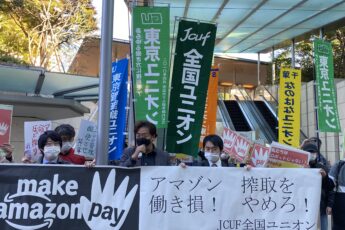
We publish the first of two texts reflecting on the emergence of logistics infrastructures in Georgia and the impact of the «One Belt, One Road» initiative on the country. The texts are the result of discussions with activists from Georgia and Solidarity Network – Workers Centre Tbilisi who joined the TSS Platform. This first text provides a background on the country’s recent infrastructural history. In Georgia, as well as in many of the European peripheries crossed by the New Silk Road and the corresponding neoliberal reforms, labour rights have been corroded to a minimum and long-standing distrust in Union practices is undermining labour organising. This text shows that logistics goes beyond a single labour sector investing the entire society and shaping the political future. Moreover, taking logistics in its transnational dimension shows that this peculiar situation resonates with dynamics happening also in countries still characterized by a relatively higher degree of unionization, blurring any clear-cut distinction between «centres» and «peripheries». This invites us to think about new strategies for struggling against the logistical restructuring, within and without the workplaces, capable of considering at the same time differences, commonalities and interrelations. This text and the following one, which will reflect on the possibilities and obstacles for transnational labour organising from the standpoint of logistical transformation in Georgia, are therefore aimed at opening up the TSS horizon to a differentiated, albeit increasingly common, landscape. We adopt an extended conception of Europe reflecting together on the challenges for transnational labour organising presented by the expansion of the New Silk Road. As the global circulation of the strike shows us, our transnational initiative cannot stop at the EU institutional borders. This holds true also considering how EU policies are by now structurally stretching beyond its borders. In order to set our struggle on the scale of their potentiality and of the attack we are experiencing we need to enlarge our horizon and to build our own global chains of insubordination across regions and countries. These contributions aspire to trigger a discussion on how to organize transnationally inside and against logistics and how to make a decisive move towards the forthcoming TSS transnational meeting on logistics and related struggles.
A Transit Corridor
Georgia, the post-Soviet republic in the South Caucasus, is undergoing its own logistics revolution. Historically defined by its strategic position between East and West – Europe and Asia – this country’s longstanding cultural and geopolitical ‘liminality’ has been translated into an income-generating vocation. In the early 2000s its position in-between competing regions informed the decision to build a stretch of the Baku-Ceyhan pipeline across the South-Western part of the country. Over ten years after the completion of the pipeline, Georgia is witnessing a new wave of infrastructural investment. Currently outside of the European Economic Area, Georgia nevertheless benefits from bilateral trade agreements with the EU and, as of January 2018, with China. Such a favourable trade position makes this country a perfect platform for the multi-sited manufacturing and transit of foreign goods. The Chinese corporation HuaLing, one of the most prominent foreign investors in the country, claims that “Georgia resembles a stretched-out hand, which accepts and connects Europe and Asia” (HuaLing Group 2015), a definition which willingly plays with historical narratives that portray Georgia as a quintessentially logistical territory.
The Eurasian Energy Corridor, transiting across Georgia, includes three transnational pipelines and four port facilities. Moreover, recent major infrastructural investments in Georgia such as the Baku-Tbilisi-Kars railway line and a new highway connecting the East of the country with its Western ports are aimed at strengthening its position as an over-land transit corridor. Amongst them is a deep-sea port in the town of Anaklia, situated at the border with Abkhazia, which will be completed in 2020. With an initial investment of 590 million US dollars, the port is intended to become the main logistic gateway on the Black Sea and one of the strategic hubs of ‘One Belt One Road’, the Chinese-led infrastructural project also known as the New Silk Road. Far from being simply concerned with transit this project implies a strategic rearrangement of the territories it crosses, generating new markets on its way – a fundamental outlet for the bursting Chinese market – and consolidating China’s influence as a hegemonic manufacturing force on a global scale.
The New Silk Road and The Belt and Road Forum
It is against this background that ‘The Belt and Road Forum’ was held in Tbilisi, the capital of Georgia, on 28 and 29 November 2017. This meeting, which follows the one held in Beijing in May this year, consolidates this post-Soviet country’s bid to establish itself as a key point in the development of the ‘New Silk Road’. Whilst the extension, the routes and the territorial impact of this project are still under discussion, the Chinese government expects a traffic of $24 trillion worth of commodities by 2030 and is engaged in an infrastructural effort never seen before, allocating almost a billion dollars as of today to develop the infrastructures necessary to activate the various corridors. The Tbilisi Belt and Road Forum, therefore, hosted for two days the speculations, predictions and performances that characterize the expansion of this huge logistic network.Throughout the forum, Georgia presented itself as a new model for global connectivity. But what exactly are the tools to achieve this enviable position?
Infrastructural Development and Reforms
The Minister of Sustainable Economy Dimitry Kumsishvili summarizes them in his speech. In order to talk about connectivity, it is clear how infrastructures provide a starting point. These are currently quite poor on the Georgian territory, however in 2016 the government launched a four-item spatialplan that expects investment of 3.5 billion dollars to speed up transit connections. The plan foresees for 2020 the construction of two logistics centres on the outskirts of Tbilisi and Kutaisi, 550 km of motorways and an upgrading of the railway network that will connect the canter of the country with the Black Sea coast where the port of Anaklia will arise.
Anaklia port and city
Alongside the port project Anaklia Development Consortium is designing an entirely new city based on data-driven technologies, actively propagating the concepts of smart and green city under the name of sustainability. “Anaklia City” is initiated by profit oriented private sector, it is not going to have the social ends that other governmentally run smart city projects intend to have. Following this, it’s clear that with this initiative the executors aim at creating a smart and “sustainable” infrastructural landscape that will not be designed to improve the lives of people but will in the first place allow for track and control of the movement of workers, as well as management of uncertainty and reducing the risks through gathering the vast amounts of data.
It’s worth mentioning that “Anaklia City” is not a first attempt of developing a new city right next to the conflict region of Abkhazia. Lazika was another city planned by previous government in 2011, which never came to completion. The PR campaign of Anaklia Development Consortium deliberately underlines the multitude of attempts from mid-19th century onwards of developing the port in Anaklia, using the errors not as a problem of methodology but only as an example of bad management. With speculative hopefulness and positivity, that is characteristic for such developments the executors justify another trial and keep the population of region in the state of hope and waiting.
Soft Infrastructure
From the overview provided by the minister, however, it emerges that material infrastructures – present and future – are in the background if compared to the network of business-oriented ‘soft infrastructure’ that the country has developed over the 25 years of independence.
These reforms can be characterized with one word: deregulation. According to the World Bank, the minister argues, no other country has managed to implement such a broad portfolio of reforms to promote free trade in such a short time. This granted the country the ninth place in the World Bank Doing Business Report ranking for its benefits business. Bureaucracy and the thirteenth place on the list compiled by the Heritage Foundationon economic freedom.
Labour
Another factor cited as fundamental for the Georgia’s ‘success’ is the weakness of its labour code: Georgian workers are defined in the various presentations as: ‘competitively priced workforce’. Georgian legislation does not include minimum wage regulation which, paired with the absence of an effective system of labour inspections, guarantees a cheap and highly blackmailable labour force. In Georgia there are today four free industrial zones (FIZ), the workings and territorial organization regimes at play in these zones emerge in this forum as the model to be imitated for the logistics development of the whole country. Within these spaces, rights recognized as fundamental – at least on paper – for the citizens of a state, such as the right to express dissent, or workers’ rights are dislocated for the benefit of more fluid and seamless exchange processes. Therefore, in these spaces, efficiency and rapidity dominate over the human component of the processes.
The normalization of these spaces as a preferential territorial form for the development of the New Silk Road has practical and discursive consequences. On one side, observing the working conditions and recent struggles in the logistics sector on a local and global scale we can get a hint of the practical implications of the ‘zonification’ of economic processes;on the other, the rhetoric adopted by the participants in the forum, exemplifies the discursive implication of this economic logic: in the many hours of debate on the projects of the new Silk Road, workers are hardly ever mentioned. Although it is often indicated that infrastructure investments will produce a large number of jobs, it is never specified what kind of employment, for whom, and under what conditions. The only times the workforce is mentioned is to describe it as ‘competitive’ – an adjective that clearly does not refer to its skill level but to its low price. Consequently, the labour force is only discussed as a commodity, one of the various ‘assets’ that Georgia has to offer potential investors.
Interestingly, Anaklia Development Consortium is admitting the ineffectiveness of Georgia’s labour code, promising to upgrade it to higher the standards. This is part of their social responsibility image and their bid to appear as guarantors of a modern path to development. However, while the founder of Anaklia Development Consortium, Mamuka Khazaradze openly talks about the lack of skilled labour force(the70% of job applications received by the consortium were for driver jobs), of course no effort has been made by the government to upgrade the skills of the labour force, a task which has been handed over to the private sector.
Logistics and Time
When trying to understand the development of logistics infrastructure in Georgia – and the possibilities to subvert or domesticate it – the question of time becomes central. The rise of logistics as a structuring element of contemporary global capitalism has been tightly linked with the production of new forms of spatio/temporal organization of global space. Logistics investments in Georgia come after decades of uncertainty, wars and economic crisis, followed by harsh privatization of spaces and services. To keep up with official discourses which portray logistics connection as seamless and fast, the ambitious four-item spatial plan launched by the Georgian government in 2016, aims at re-building large parts of Country’s transit infrastructure by 2020. The near future symbolized by that date, when the inauguration of Anaklia’s port is also expected, has come to occupy a central place in narratives around Georgia’s development, setting the country’s in a state of – seemingly perpetual – anticipation. This state of anticipation means that the continually receding horizon of the future determines our actions in the present. In Georgia this anticipation orders the lives of different social groups – from those in charge of governing the country to the young and not so young people hoping to be employed in one of the new logistics sites. As a structuring force for people’s lives, anticipation and waiting become fundamental to think about the possibility of labour organising.
Given this situation, the task at hand for the composition of potential labour struggles in Georgia starts with an exercise in mapping the ongoing logistics developments as well as the existing and future labour conditions which populate them, trying to anticipate ourselves a set of conditions that have not yet fully asserted themselves. Unlike other contexts where the logistic sector is already highly developed, and the labour force has access, at least to some extent, to union membership, Georgia sees a largely unprepared labour force – both in terms of organising potential and skills – due also to the novelty of the development of the logistics sector. To this practical unpreparedness, the state of uncertainty and expectation which surrounds the development of infrastructural projects adds an extra obstacle to the elaboration of workers’ demands in front of the upcoming developments. We know, on the other hand, that everywhere logistics is designed to weaken the potential of insubordination through fragmentation, precarization and isolation, and the challenge of organization impliesthe capacity to counteract this design, within and beyond the Georgian borders.






